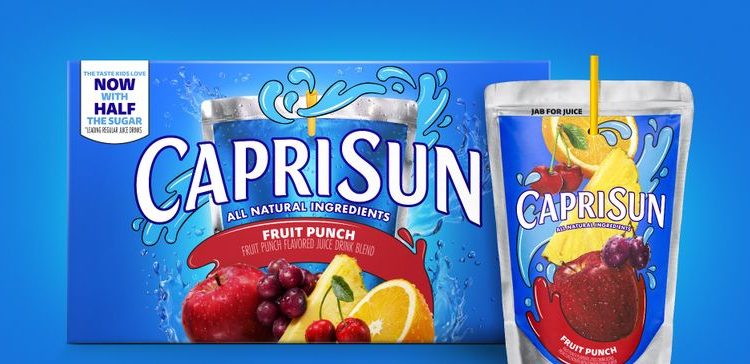Dive Brief:
- Capri Sun has reformulated its original juice drink pouches with monk fruit concentrate, which reduces the sugar per serving by an average of 40%, Kraft Heinz says. This is the largest renovation to the Capri Sun product line since it launched in 1986.
- Kraft Heinz previously committed to reduce the total sugar in its entire product portfolio by more than 60 million pounds by 2025. This change in Capri Sun will account for more than half of that goal, the company said, and can help it reach its commitment a year early.
- As companies work to reduce all sugars in their products — especially those that are added — natural sweeteners like monk fruit are becoming much more attractive to them.
Dive Insight:
No matter how it’s formulated, fruit juice is often a sugary beverage choice. Fruits themselves are packed with natural sugars, and 100% fruit juice can have the same sugar content as soda.
In many Capri Sun varieties that are not 100% juice, sugar is the second listed ingredient, right behind water. According to images of Nutrition Facts panels for various varieties of Capri Sun, those that are not 100% juice can have as much as 13 grams of sugar with 11 grams added.
A monk fruit-sweetened version takes this down to an average of 8 total grams of sugars with 5 grams added, according to Kraft Heinz. The revamped juice pouches are slated to hit shelves in August with packaging that highlights their lower sugar content compared to other kid-targeted juice boxes.
Monk fruit is native to China and is intensely sweet. Monk fruit sweeteners are 150 to 200 times sweeter than sugar, so much less is needed, according to the International Food Information Council. The sweetener has zero calories, does not promote tooth decay and is safe for people with diabetes to consume.
Several monk fruit-derived sweeteners have generally recognized as safe status from the FDA, and the ingredient is available both to consumers as well as in food products. It stays stable under heat, and can be used in baked products, though on its own it is most often an addition to beverages. Monk fruit can have an aftertaste that is reminiscent of a melon rind, and is often used in combination with other natural sweeteners, including stevia, allulose and erythritol, to make a blend that is more palatable. According to Monk Fruit Corp., the sweetener can be found in more than 2,000 CPG products, including gelato and coffee drinks.
Kraft Heinz CEO Miguel Patricio said in prepared remarks accompanying Wednesday morning’s earnings report that the shift to monk fruit also makes Kraft Heinz less subject to volatile sugar markets, which is important as inflation and supply chain issues drive prices up.
While a statement said Capri Sun made this change in response to parents’ concerns about sugar in kids’ juice boxes — a huge stumbling block for the segment — this reformulation has a wider impact on the juice market and CPG products as a whole. Some products are designed using alternative sweeteners, while others are reformulated in stealth, where consumers don’t necessarily know that changes have been made.
But a large-scale and widely announced reformulation of one of the top-selling juice box brands brings much more attention to what has been done and why. If a big brand like Capri Sun, owned by a behemoth like Kraft Heinz, can reformulate to slash added sugars, it may inspire other CPG makers to look at alternative sweeteners. If the reformulated Capri Sun’s taste experience is similar, and as long as parents keep buying it, this kind of reformulation shows that sugar reduction can work.
Editor’s note: This story has been updated with information from Kraft Heinz’s quarterly earnings.
Source by www.fooddive.com















































